The Pilcomayo River frequently floods, creating a reoccurring disaster of lost lives and property for the rural communities of South America’s Gran Chaco region. Unlike most rivers, during the rainy season up to a third of the Pilcomayo’s volume is sediment carried in the water, and its path is unpredictable. When the muddy river floods its banks, it deposits that sediment in huge mounds of mud, at times burying entire houses and cars.
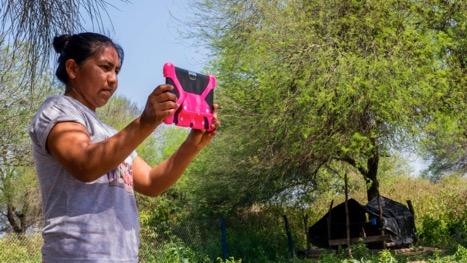
Further from the river, the Gran Chaco is a dry region ranging from central Argentina through western Paraguay and southeastern Bolivia. It’s home to over 7 million people (of whom 8% are Indigenous peoples), many of whom engage in agriculture, livestock, beekeeping and handcrafts for work. Over the last two decades, climate change — made worse by massive deforestation to plant industrial crops and raise livestock — has greatly threatened these livelihoods. Droughts are becoming longer and more frequent, and the rainy season is no longer reliable. When rain does come, floods overtake the landscape.
In January and February of 2018, forecasts predicted the biggest flood the region had experienced in the last 35 years. The flood came, but this time was different — most property was salvaged and no lives were lost.
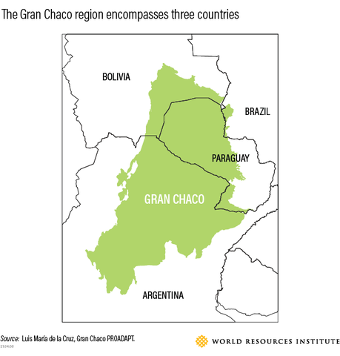
What changed? People in even the most remote towns had several days’ warning. Not only that, but community groups coordinated with provincial governments from Argentina, Bolivia and Paraguay to monitor and take preventive measures before the water arrived.
Though most had never heard of the formal term “climate resilience,” the Chaco’s communities nevertheless organized to tackle the local effects of the climate crisis. They’ve built trust between far-flung communities and with local authorities across the three countries, and created spaces for community members — especially women — to make decisions. Now others in Argentina and elsewhere are learning from their example. And governments and international institutions worldwide are increasingly recognizing the importance of locally led adaptation efforts, and committing to support them.
Building a Grassroots Network to Tackle the Gran Chaco’s Challenges
In the 1990s, four strangers from four different towns in the Gran Chaco began traveling between Argentina and Paraguay once a year to meet with the region’s communities and brainstorm how to respond to common challenges like low agricultural productivity, drought and floods.
Luis María de la Cruz, from the small town of Vaca Perdida in Argentina, was one of those four original strangers. Over the years, more and more people from different communities joined these meetings and other informal gatherings, realizing that they had much in common. For example, they voiced their frustration with how the government developed a large project to divert the Pilcomayo River into two channels without consulting communities.
As a result of these meetings, community organizations in the Chaco region began to form and collaborate on initiatives to advance land rights, water access, sustainable business practices, women’s leadership and, today, climate adaptation.
“Everyone realized that, if they are not the protagonists, more interventions will arrive that don’t take their interests into account,” said de la Cruz. “Policies would continue to be defined without people.”
Some of these organizations formed a network in 2009 called Redes Chaco — an expansive platform including farmer’s associations, women’s collectives, youth groups, local authorities and other institutions. Members meet regularly to discuss the region’s priorities, share experiences and agree on how to advance large-scale initiatives such as Indigenous Coordination to protect land rights and the Gran Chaco Women’s Collective which leads a gender equality agenda for the region.
“It’s important to take whatever time is needed to generate trust and caring towards the group. This we learned from Indigenous peoples,” said Pablo Frere, a veterinarian and Redes Chacos Executive Secretary, based in the city of Salta in Argentina. “Creating spaces for trust has permitted the mobilization of many different initiatives and 20 million dollars.”

A Crowd-Sourced Early Warning System for Floods
Thanks to the mutual trust and collaborative spirit of Redes Chaco, a related effort called Gran Chaco Proadapt helped create a flood early warning system to prevent deaths, minimize property damage and avoid production losses. Gran Chaco Proadapt is a tri-national initiative between civil society organizations, the local private sector, local governments, and national and international climate funders.
By providing information on the behavior of the river before and during rainstorms, the project has substantially enhanced local climate adaptation efforts. According to the Global Commission on Adaptation, just 24 hours warning of a coming storm can cut the ensuing damage by 30%.
“There was an intense map-reading literacy program and other tools to help with monitoring and understanding images from space,” said de la Cruz, an anthropologist who became a pioneer in developing these participatory early warning maps. Combined with new modes of communication, in this case WhatsApp and Telegram, this program became a powerful instrument.
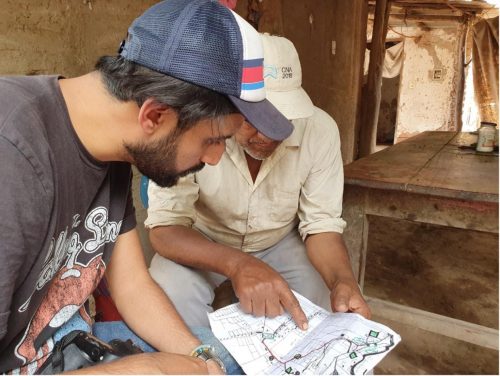
In 2015, a group of farmers created a WhatsApp group to share river alerts and explain the implications of weather and hydrological alerts quickly and effectively. Since then, more groups have formed, spanning countless communities and all three countries. Members who can see the river rising will post photos; other members will explain and compare it with satellite imagery; others will warn their communities of the impending danger.
“Before, when it rained some people would lose their houses. Now I am in this [WhatsApp] group and I check if it’s going to rain, if it’s going to flood. Thanks to the connection, we are okay,” shared Norma Rodríguez, President of the Cooperative of Women Handcraft-makers (COMAR). “It’s important because we didn’t have that before; no one knew anything. Sometimes it would flood and no one knew until the water arrived. Today when the river grows, we all know.”
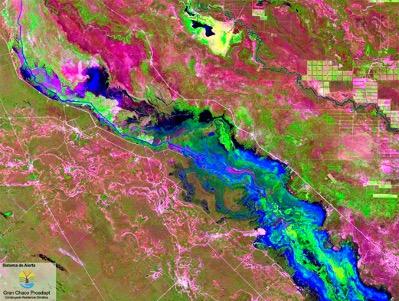
Equipping Women Leaders with Digital Tools to Adapt and Thrive
As part of their adaptation and development strategy, the collective Gran Chaco organizations also set up 20 digital centers in very remote regions to facilitate connectivity and teach women how to use computers and digital tools to access climate information. These centers are established at the headquarters of primarily Indigenous women’s associations, thus empowering and legitimizing local actors. Each community chooses their learning priorities and a tutor from their own community.
Thanks to these efforts, about 35,000 people now have access to the internet or mobile phone for the first time. In the past few years, 370 female leaders have learned to map risks and adaptation practices, producing four territory risk maps, a manual on good adaptation practices, and a Climate Change and Gender Diagnostic and Strategy for the region. These centers not only keep communities safer from climate hazards, but they’ve also created new income opportunities. Local women use the digital centers’ computers to sell their crafts and other business products online, apply to scholarships, electronically process their pension forms, and more.
For many years, men made all the decisions in the region. But thanks to Redes Chaco’s participatory and inclusive model, that’s changed. Now, more than 200 grassroots women’s groups have joined the Gran Chaco network and more traditional and equal decision-making is returning.
A new initiative, started in May 2020, Nanum: Women Connected in the Great American Chaco, is building upon these adaptation and rural connectivity efforts in an additional 40 isolated communities. In three years, Nanum funds will create women-led enterprises in each of these communities to provide internet service.
“The project seeks to promote the role of women as agents of change in their communities with regard to access and adoption of disruptive solutions. Wherever women were incorporated, they saw the adaptation processes accelerate,” said Florencia Iacopetti, program manager of the Avina Foundation, which is coordinating Nanum.
The women-led digital centers have been essential in alerting surrounding communities of impending floods, including the one in 2018. They allow every community member to access vital climate information and give them a way to connect with the rest of the world.
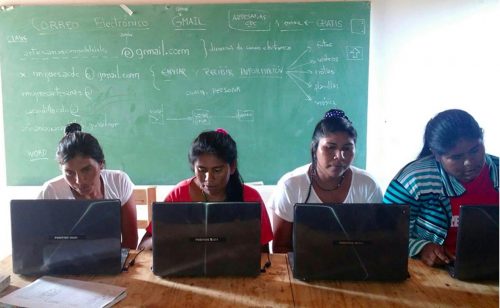
Supporting Locally Led Climate Adaptation
Local and national governments are impressed with the milestones achieved by the Gran Chaco’s communities — and community members now have a direct say in regional development and adaptation planning. In Argentina, the Ministry of Environment has followed their example and consulted with the Proadapt network to develop its National Adaptation Plan.
When Argentina hosted the G20 summit in 2018, Gran Chaco women’s farming organizations, civil society groups and businesswomen were invited to share their priorities on the international stage. By using WhatsApp and video calls, more than 300 women from over 65 organizations met over the course of a year to develop recommendations ahead of the summit. This group now forms the Rural Women of Argentina Network and is advancing the gender and climate agenda at the national level.
Communities in the Gran Chaco region embody locally led approaches to climate adaptation, which put local people at the front of decision-making and leadership. The Principles for Locally Led Adaptation, coordinated by WRI and International Institute for Environment and Development (IIED) under the Global Commission on Adaptation call for greater decision-making power and funding for local actors to design, prioritize, implement, monitor and evaluate climate adaptation activities. They also call for local people to be seen not just as beneficiaries, but rather as full partners — as they are in the Gran Chaco region’s initiatives.
The Principles have been endorsed by over 40 governments and organizations, and we hope more will follow suit this year. Going forward, locally led action is vital to protect people and ecosystems from climate change.
As Redes Chaco Executive Secretary Pablo Frere pointed out, “Everyone has valuable knowledge, be it empirical or not. Every one of us is part of the solution.”
This blog was originally posted by World Resource Institute on 26 April. You can read the original here.

Comments